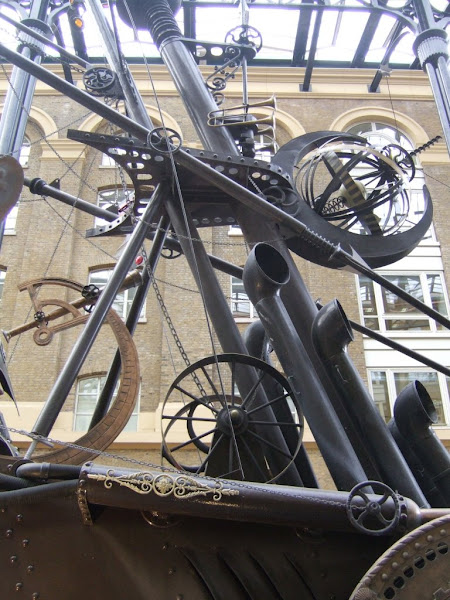'Actually I know David,' said Si. 'He has a studio on the cliff tops at Botallack and I'm planning to visit him soon to take some photos.'
Before we see those photos, let me show you the kind of work that David has become quite rightly celebrated for. This is Old King Coal on the Sustrans railway path at Pelton Fell in County Durham.
The sculpture was built with the help of local volunteers and redundant miners and steelworkers and was completed the same day as the last colliery closed in County Durham. The materials used included a giant ventilation fan, miners' shovels and bricks from demolished steelworks.
David was also commissioned by John Grimshaw, director and chief engineer of Sustrans, to build a series of milestone and landmark sculptures, using discarded materials found on nearby post-industrial sites. Among the other pieces David completed were a series of Easter Island-style giant heads made from old defunct electrical transformers and other scrap.
Another of his works is The Ancient Forester that stands in Grizedale Forest in Cumbria. he's made solely from wood found in the surrounding area. Well, apart from that massive axe head.
A personal favourite of mine is one of his smaller works. The Hounds of Geevor were made from redundant miners' boots from the last Cornish tin and copper mines to shut down. Several of them were cast in bronze and now stand as a monument in Redruth town centre, the capital of the old Cornish mining industry. They mark the demise of the industry.
But now, as promised, a peek inside David's studio, courtesy of my brother.
David's studio is inside a cluster of old mine buildings on the northern coastal road between Penzance and St Ives. The cliffs here are peppered with the remains of long-dead mines and offer fantastic views out onto the turbulent ocean. Much of the Poldark TV series was filmed around there.
It's delicious chaos inside the studio with curious machines and strange pseudo-tribal masks everywhere you look.
'I make things out of things, big things, little things, old things and new things.' he explains on his website. 'I like to recycle things, and find new uses for things that have been thrown away. Some things say something about their surroundings, and other things become something else.'
David is the absolute champion of this form of art and I could look at it all day. I do have a nice little book of his work that's worth getting hold of if you like it.
David's work is important because he memorialises dead industries and the lives of those who worked in them. The fact that he uses, as his raw materials, the very items that those people touched and worked with every day adds an extra layer of poignancy. He's a very gifted and important artist whose name should be better known.
I'll leave you now with a few more examples of his work.
His website is here.




























No comments:
Post a Comment